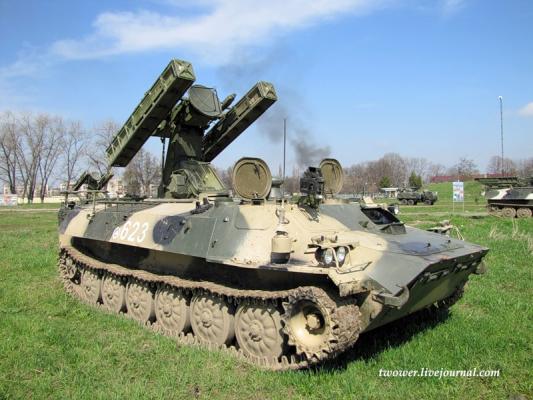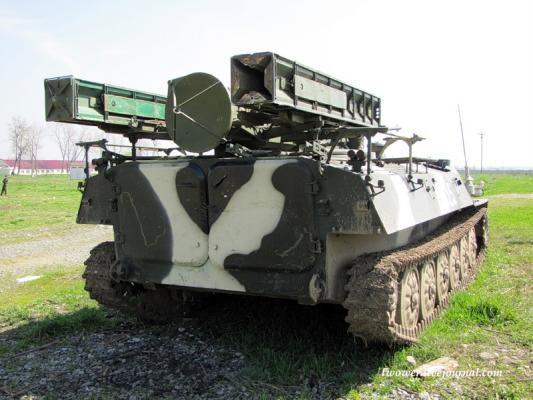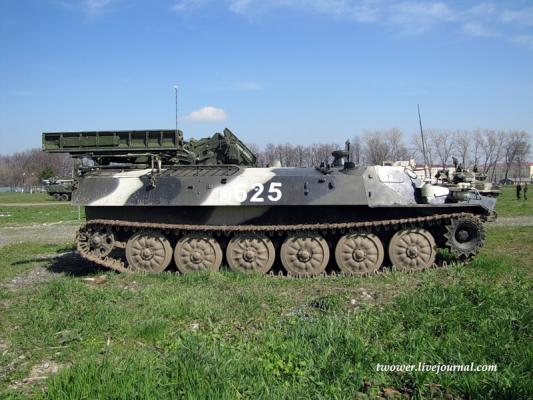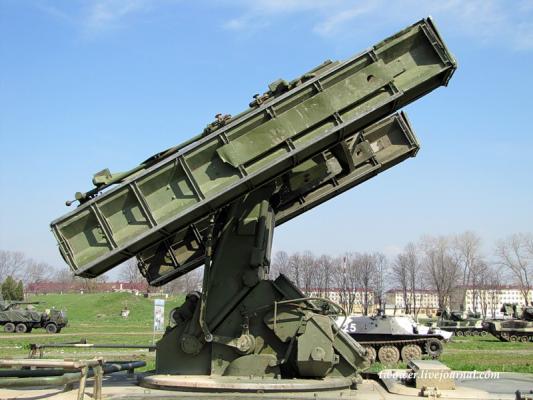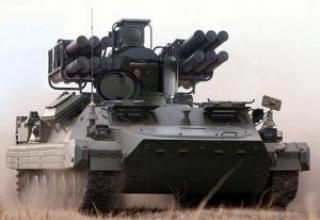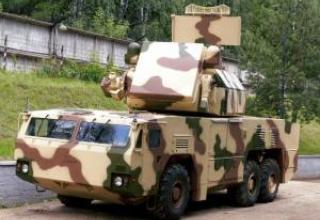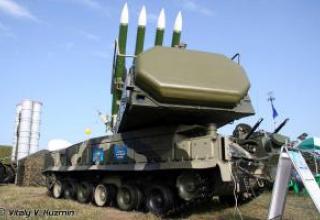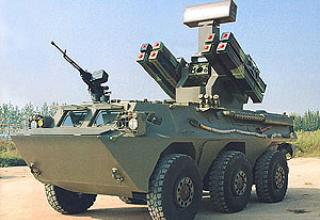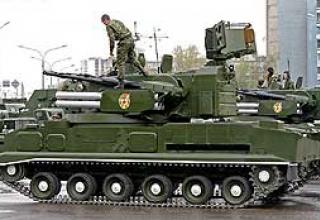Work on the development of a self-propelled air defense missile system "Arrow-10SV" (9K35) was carried out under the Decree of the CPSU Central Committee and the USSR CM dated July 24, 1969. Despite the fact that in the same period the development of an anti-aircraft missile system "Tunguska", the creation of a relatively simple anti-aircraft system in order to further improve the air defense system type "Arrow-1M" was considered appropriate for economic reasons. At the same time, the tactical purpose of such a complex as an addition to the Tunguska complex, capable of ensuring the destruction of suddenly appearing low-flying targets in a complex air and radio electronic environment.
As during the development of the Arrow-1 SAM system, the Design Bureau of Precision Machine Building (KBTM) was determined to be the lead organization for the development of the 9K35 SAM system as a whole, as well as 9M37 missiles, air defense launch equipment and a testing machine, and the Central Design Bureau of Geophysics was determined to be the lead organization for the development of the GSN and non-contact fuse for SAM.
According to the task, the "Arrow-10SV" complex was to provide:
- Defeat of targets flying on counter courses at speeds of up to 415 m/s (up to 310 m/s - on catch-up courses) at altitudes from 25 m to 3500 m, at ranges from 800 to 5000m with a parameter of up to 3000m;
- probability of hitting a single SAM of a single target maneuvering with overloads up to 3...5ed., not less than 0.5...0.6 in the presence of target designation from the air defense controls of the regiment and in the absence of organized obstacles and traps;
- possibility to fight targets both autonomously (with visual detection of targets) and in the centralized control system when receiving target designation via voice radio channel from the control unit PU-12 (PU-12M);
- air transportability (on An-12B and Mi-6) and possibility to overcome water obstacles afloat.
By early 1973, the Strela-10SV SAM system was presented for joint testing. The tests were conducted at the Donguz range from January 1973 to May 1974. After eliminating the shortcomings identified during the tests, the 9K35 complex was adopted by the Decree of the CPSU Central Committee and the USSR CM of March 16, 1976.
Series production of combat vehicles of all modifications of the "Arrow-10SV" complex was organized at the Saratov Aggregate Plant of MOS, and missiles - at the Kovrov Mechanical Plant of MOS.
Arrow-10SV SAM systems were supplied to a number of foreign countries and used in military conflicts in the Middle East and Africa. They fully justified their purpose in combat operations and exercises.
On July 11, 2014 it was reported that the militia of the Donbas People's Republic had the Arrow-10 SAM system (9K35). On 11 July 2014 it was reported that the militia of the Donbas People's Republic had "Strela-10" (9K35) SAM system. The militia named the system "Frogushonok".
In the west, the complex received the designation SA-13 "Gopher".
Composition:
The 9K35 complex is part of the complex:
- Combat vehicle (BM) 9A35 equipped with a passive direction finder,
- combat vehicle 9A34 (without direction finder),
- ZUR 9M37,
- testing machine.
Unlike the Arrow-1M SAM system, the 9K35 complex (see projections) was placed not on the BRDM-2 wheeled vehicle, but on the MT-LB tracked multi-purpose tractor, the payload of which made it possible to increase the mobile ammo from four to eight SAMs (four - on the launcher guides and four - in the body of the self-propelled vehicle). At the same time, it took a long development of the combat vehicle's equipment, which was affected by powerful vibrations of the tracked chassis, not typical of previously used wheeled vehicles.
The Arrow-10SV SAM system used the electric drive of the starting device, rather than the operator's muscle power, as in the Arrow-1M system.
The 9M37 missile.
A new missile, designated 9M37, was developed for the Arrow-10SV complex (see layout chart). The 9M37 missile included a two-color homing head, and in addition to the photo contrast channel used in the Arrow-1M air defense system, a thermal (infrared) channel was used, which increased the combat capabilities of the air defense system when firing towards and inhaling the target, as well as in conditions of interference. The photographic contrast channel was used as a backup channel, because unlike the thermal channel, it required cooling, which could be provided only with a single prelaunch of the SAM.
To limit the missile's rotational speed on a roll, free-standing rollers located behind the wings of the SAM were used. While maintaining the diameter of the hull and wingspan of the Arrow-1 SAM system, the length of the 9M37 missile was increased to 2.19 m.
To improve the effectiveness of combat equipment while maintaining the same weight (3 kg) of the fragmentation and high-explosive warfare unit in the 9M37 BC ZUR were used rod attack elements. In case of direct hitting of the target by a contact sensor, and in case of missile overflight near the target by a non-contact electronic-optical sensor, a safety and execution mechanism was used to detonate the combat unit of the SAM system.
Introduction in the "Arrow-10SV" complex of the 9C86 launch zone assessment equipment, which automatically generates data for working out the required preemptive angles, allowed for timely missile launches. It was based on a coherent impulse radiodalometer of the millimeter wavelength range, which provided definition of the target range (within the range from 30 to 10300m with a maximum error not exceeding 100m) and the target radial velocity (with a maximum error not exceeding 30m/s), and not on an analog-sample counting and resolution device, which determined the launch zone boundaries with maximum errors of 300-600m and preemptive angles at launch with average errors of 0.1-0.2°.
In the "Arrow-10SV" complex it became possible to fire at faster targets as compared to the "Arrow-1M" SAM system, the boundaries of the kill zone were extended. While the Arrow-1M system was not protected from either natural or organized optical interference, the Arrow-10SV was protected from natural interference and, to a certain extent, from single intentional optical traps when operated using the CNS thermal channel. However, the Arrow-10SVs still had many limitations on the effective firing using both the photo contrast and thermal channel of the CNS.
The 9K35 SAM system was organizationally combined into the Arrow-10SV anti-aircraft missile platoon of the anti-aircraft missile artillery battery (Arrow-10SV anti-aircraft missile platoon and Tunguska complex platoon) of the motorized rifle (tank) regiment anti-aircraft division. The platoon consisted of one 9A35 combat vehicle and three 9A34 vehicles. The PU-12 (PU-12M) was used as a battery command post, which was to be later replaced by a unified battery command post "Rangzhir".
Centralized management of complexes "Arrow-10SV" in the battery and anti-aircraft division of the regiment was proposed to be carried out in the same way as the complexes "Tunguska" - through the transfer of commands and target designation from the battery commander and air defense command post of the regiment by radio telephone (before the equipment of the air defense systems data transmission equipment) and by radio telemetry (after such equipment).
Communication equipment:
- Radio station R-123M;
- Tank intercom TPU-4.
Crew: BM commander, senior operator and mechanical driver. In addition to the crew's personal weapons, each combat vehicle has a PK machine gun with two ammunition sets.
Characteristics:
| Defeat zone, km - at a distance - in height - as defined in |
0,8-5 0,025..3,5 up to 3 |
| Probability of hitting a single ZUR fighter. | 0,1..0,5 |
| Maximum speed of the targets to be hit (up/down), m/s | 415/310 |
| Response time, s | 6,5 |
| ZUR flight speed, m/sec | 517 |
| Weight, kg: - ZUR - combat unit |
40 3 |
| The number of SSDs on a combat vehicle | 8 |
| Base 9A35 - MTLB (multi-purpose light armored truck) - travel speed,km/h - afloat speed, km/h - booking - power reserve without refueling, km |
up to 60 up to 5 antibullet 450 |
Testing:
As of 01.01.1950, the factory batch of 230 shells was completed and sent to the Pavlograd test site.
In November 1949, pre-factory tests of 34 shells were carried out together with the fuse B-377 during which cases of missiles were revealed.
Special tests carried out to determine the causes of deficits showed that the most probable cause was an increased release of unburned reactive charge particles at the end of the active section of the trajectory.
In order to eliminate this phenomenon, in December 1949 a bench-top refinement of the engine was started with regard to aperture enhancement and ensuring that the powder charge was fixed in the chamber. After the end of the bench work and experimental firing for checking the reinforced aperture, the factory batch of projectiles was to be equipped with modified apertures on site and presented for factory tests in February 1950.
Sources:
- Зенитные ракетные комплексы ПВО СВ. Техника и вооружения №5-6.99
- ARMY AIR DEFENCE
- 19-я мотострелковая бригада. Боевая техника /Денис Мокрушин/
- http://voicesevas.ru/news/yugo-vostok/2684-voyna-na-yugo-vostoke-onlayn-11072014-hronika-sobytiy-post-obnovlyaetsya.html
